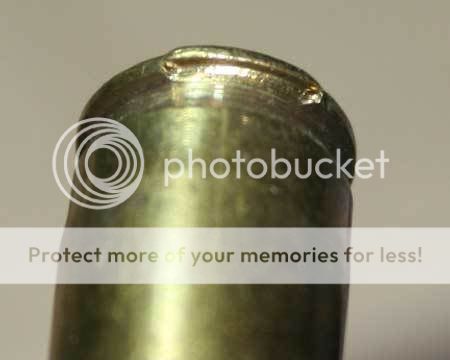nitesite
Member
A good friend, who attends several tactical training schools every year, brought back a bucket of brass and shared it with me. The academy only allowed factory new ammunition to be used and students were encouraged to take the scrounged brass out with them.
A lot of it was R-P and Federal (yeah, I won't be using the FC stuff), but around 600 cases were S&B. As I was sorting through everything I quickly noticed that about 25%-30% of the S&B cases had varying degrees of torn rims. Here's one of the more extreme examples:

Is this caused by-
a) soft brass
b) a particular rifle with a very dirty chamber experiencing difficult extraction
c) a particular rifle with a damaged or out-of-spec (too long) extractor
d) something else
It appears that the extractor claw was contacting the groove properly (not just on the outermost edge of the rim). If the extractor was too long then it would moving rearward when it contacted the rim, right?
Maybe these came from a rifle that was owned by a guy who wanted to see how long his AR could go without cleaning and by day three it was fighting hard to extract each round?
I really feel that this was a case of one rifle on that range that was experiencing "issues" but that can't dispel my doubt that the whole bunch might be made of really soft brass. So help me, please!
One more question...
Are the primers so tight that de-capping this brass might break the pin on my Lee sizing die?
I am aware of the issues with S&B regarding tight primer pockets. If this is reloadable I will ream the primer pockets after sizing and trimming.
Thanks much for any helpful comments!!!
A lot of it was R-P and Federal (yeah, I won't be using the FC stuff), but around 600 cases were S&B. As I was sorting through everything I quickly noticed that about 25%-30% of the S&B cases had varying degrees of torn rims. Here's one of the more extreme examples:

Is this caused by-
a) soft brass
b) a particular rifle with a very dirty chamber experiencing difficult extraction
c) a particular rifle with a damaged or out-of-spec (too long) extractor
d) something else
It appears that the extractor claw was contacting the groove properly (not just on the outermost edge of the rim). If the extractor was too long then it would moving rearward when it contacted the rim, right?
Maybe these came from a rifle that was owned by a guy who wanted to see how long his AR could go without cleaning and by day three it was fighting hard to extract each round?
I really feel that this was a case of one rifle on that range that was experiencing "issues" but that can't dispel my doubt that the whole bunch might be made of really soft brass. So help me, please!
One more question...
Are the primers so tight that de-capping this brass might break the pin on my Lee sizing die?
I am aware of the issues with S&B regarding tight primer pockets. If this is reloadable I will ream the primer pockets after sizing and trimming.
Thanks much for any helpful comments!!!


